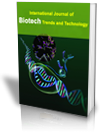Study of removal of cod by guargum with coagulants alum and polyaluminium chloride in wastewater treatment
 |
International Journal of Biotech Trends and Technology (IJBTT) |  |
| © 2013 by IJBTT Journal | ||
| Volume - 3 Issue - 1 |
||
| Year of Publication : 2013 | ||
| Authors :B.Saritha, G.Sharmilaa |
Citation
B.Saritha, G.Sharmilaa "Study of removal of cod by guargum with coagulants alum and polyaluminium chloride in wastewater treatment",International Journal of Biotech Trends and Technology (IJBTT), V3(1):11-19 Jan - Mar 2013. Published by Seventh Sense Research Group.
Abstract
This project work was conducted to study removal of COD from tannery effluent by coagulants which includes analysis of physico-chemical parameters of tannery effluent as well as the treatment efficiency of alum, PACl, their combination (alum + guargum) and (PACL + guargum). Sample collection and analysis were performed using standard methods for the examination of water and wastewater (1998). Tannery effluent has been treated with the coagulants. The influences of pH and coagulant dosages were studied. The effectiveness of chemical coagulants and guargum were measured by the reduction of COD. The results shows that the combination of coagulant PACl + guar gum is more effective than alum, PACl and alum +guargum. It can achieve upto 97% of COD reduction at low dosage of PACl (100 mg/l)and guargum (500 - 1000 mg/L). The results indicate that lower quantities of PACl are needed to obtain an acceptable reduction in COD in the treatment of tannery effluent.
References
1. APHA-AWWA-WPCF (1998) ‘Standard methods for the examination of water and wastewater’, 19th Ed., Washington DC.
2. Aboulhassan, M. A. Yaacoubi, A. and Souabi, S. (2007) ‘Pollution reduction and biodegradability index improvement of tannery effluents’, Int. J. Environ. Sci. Tech., Vol.5, No.1, pp. 11-16.
3. Eckenfelder, (1989) ‘Industrial water pollution control’, pp. 92.
4. Haydar,S. Aziz,J.A, and Ahmad, M.S. (2007) ‘Biological Treatment of Tannery Wastewater Using Activated Sludge Process’, Pak. J. Eng. Appl. Sci., Vol.1, pp. 61-66.
5. Lofrano, G. Belgiorno, V. Gallo, M. Raimo, A. and Meriç,S.(2006) ‘Toxicity reduction in leather tanning wastewater by improved coagulation flocculation process’, Global Nest Journal, Vol. 8, No.2, pp. 151-158.
6. Metcalf and Eddy, ‘Wastewater Engineering’ (4th Ed.)
7. Nazmul Islam, K.M. Khaled Misbahuzzaman, Ahemd Kamruzzaman Majumder and Milan Chakrabarty, (2011) ‘Efficiency of different coagulants combination for the treatment of tannery effluents - A case study of Bangladesh’, African Journal of Environmental Science and Technology, Vol.5, No.6, pp. 409-419.
8. Shen, T.T. (1999) ‘Industrial pollution prevention’ Springer, (2nd Ed.), pp. 40. 9. Shouli, A.S. Bewtra, J.K. Biswas, N. (1992) ‘Effectiveness of coagulation and flocculation processes in removal of selected volatile organic contaminants from wastewaters’, Int. J. Environ. Stud., Vol.40, pp. 2-7.
10. Sajjad Haydar, Javed Anwar Aziz (2009) ‘Characterization and treatability studies of tannery wastewater using chemically enhanced primary treatment (CEPT)—A case study of Saddiq Leather Works’, Journal of Hazardous Materials, Vol. 163, No. 2–3, pp. 1076–1083.
11. Sajjad Haydar and Javed Anwar Aziz (2009) ‘Coagulation– flocculation studies of tannery wastewater using combination of alum with cationic and anionic polymers’, Journal of Hazardous Materials,Vol.68, pp. 1035-1040.
12. Song, Z. Williams, C.J. and Edyvean,R.G.J. (2004) ‘Treatment of tannery wastewater by chemical coagulation’, Desalination, Vol.164, No.3, pp. 249–259.
13. Zouboulis, A.I. Samaras, P. and Ntolia, A. (2006) Study of tannery wastewater treatment in a leather industry of the area of Kastoria, 2nd international conference, AQUA – 2006.
Keywords
Tannery effluent, alum,PACl, guargum,COD.
